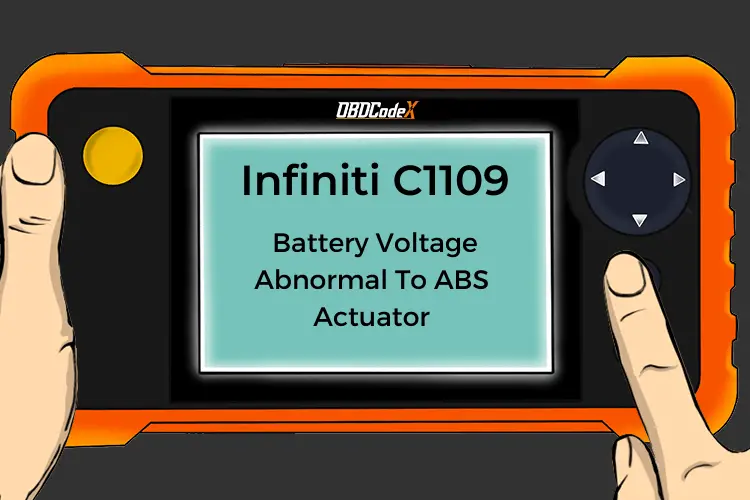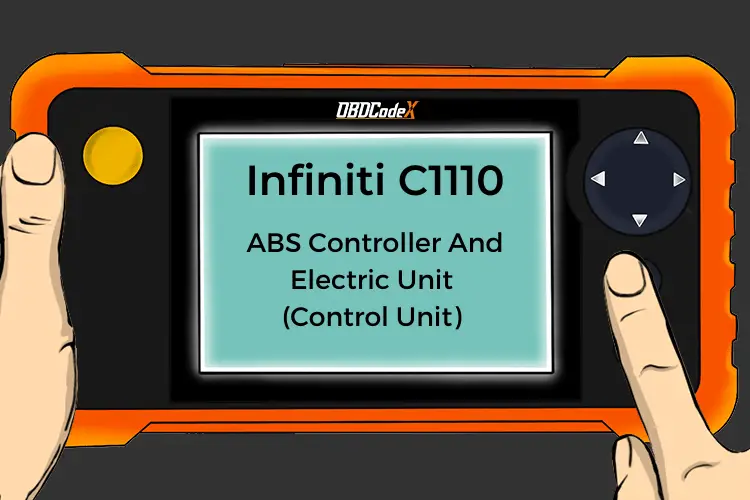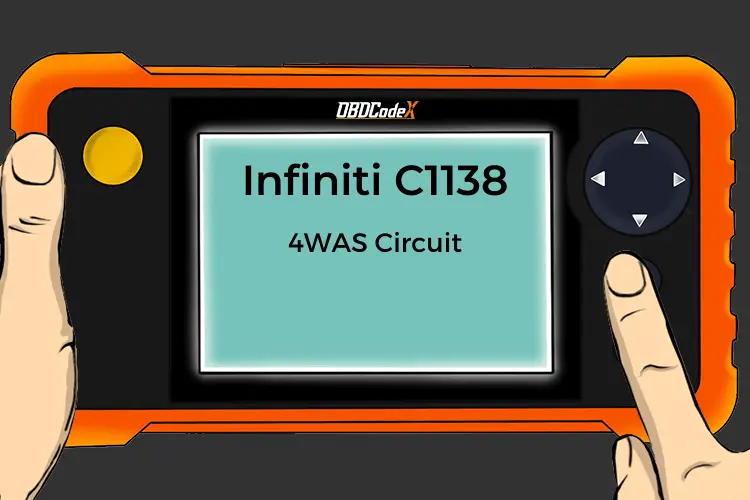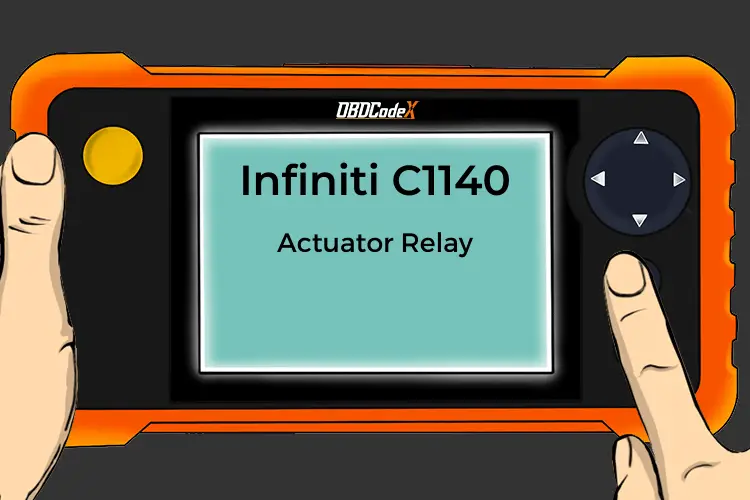Nissan C1109: Battery Voltage [Abnormal]
Is your scanner showing Nissan C1109?
No worries. We'll show you what it means and how to deal with it.
Nissan C1109: Battery Voltage [Abnormal]
OVERVIEWWhat Does The Nissan C1109 Code Mean?
The C1109 code is a common diagnostic trouble code found in Nissan vehicles, particularly on models such as the Nissan Murano, 370Z, and Pathfinder. This code indicates a problem with the ABS hydraulic pump motor circuit.
The ABS hydraulic pump motor creates pressure in the brake fluid, which assists in avoiding wheel lock-up under hard braking or on surfaces with low friction. The C1109 code is triggered when the voltage supplied to the ABS actuator and electric unit (control unit) is either too low (10V or less) or too high (16V or more).
What Are The Symptoms Of The Nissan C1109 Code?
Symptoms of the C1109 code can vary depending on the severity of the issue. The most common symptom is the illumination of the ABS warning light on the dashboard.
Sometimes you may also see the VDC off and/or SLIP warning light turn on. The VDC (Vehicle Dynamic Control) and traction control systems are closely linked with the ABS system. If the C1109 code is triggered, it can cause the VDC off warning light to turn on, indicating that the VDC system is not functioning properly. The SLIP warning light may also turn on, meaning that the vehicle’s traction control system is malfunctioning.
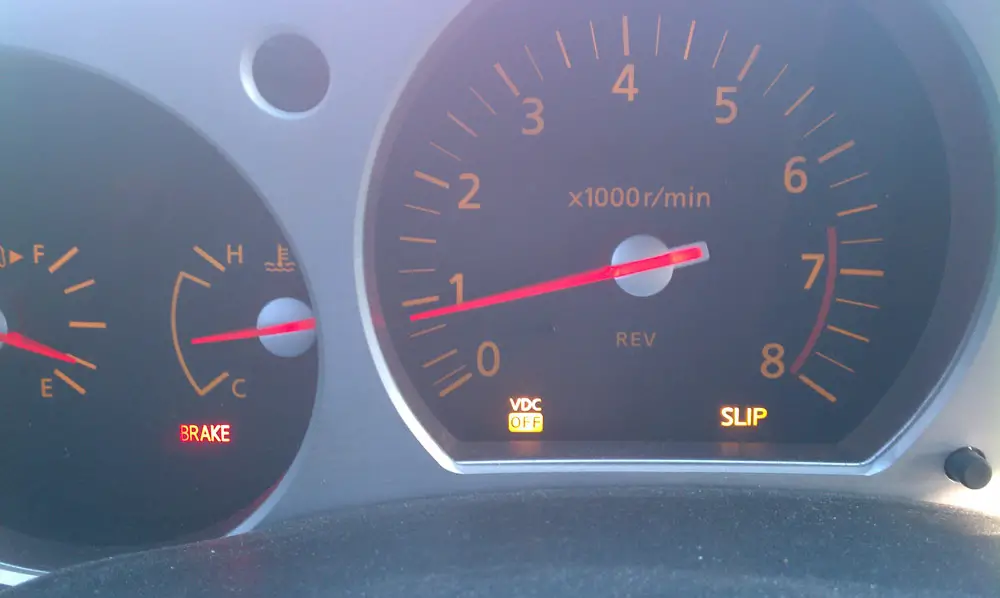
The VDC OFF and SLIP warning light turning on (Source: my350z.com)
Other symptoms may include:
- Decreased braking performance
- Unusual noises coming from the ABS system
- Overall decrease in vehicle stability during braking
- Increased stopping distance
- Reduced traction control
What Are The Potential Causes Of The Nissan C1109 Code?
Identifying the underlying cause of the C1109 code in Nissan is essential for effective repairs, as it can result from multiple factors. Some of the most common causes are:
- Damaged, corroded, or disconnected wiring and connectors
- Malfunctions or failures in the ABS actuator and electric unit
- Blown fuse(s) in the ABS system
- Ignition power supply system issues such as failing battery or faulty alternator
- Weak or failing battery
It’s important to note that these are just some of the potential causes of the C1109 code on Nissan vehicles. Other factors, such as sensor failures or hydraulic system issues, can also cause the code to be triggered.
How Serious Is This Nissan C1109 Code?
The seriousness of the Nissan C1109 code can vary depending on the severity of the issue and the specific vehicle model. In general, this code is considered high severity as it can affect the vehicle’s braking performance and overall safety.
If you experience any symptoms of the C1109 code, as mentioned above, it’s important to have the issue diagnosed and repaired as soon as possible. Continuing to drive the vehicle with these symptoms can be dangerous and increase the risk of an accident.
However, if the issue is minor and does not affect the vehicle’s performance or safety, it may be possible to continue driving the vehicle for a short period of time until the issue can be addressed. It’s important to consult with a qualified mechanic to determine the severity of the issue and whether it is safe to continue driving the vehicle.
In any case, it’s important to diagnose and repair the issue as soon as possible to prevent further damage and potential safety hazards on the road.
How Can You Fix The Nissan C1109 Code?
If you’re looking to fix the Nissan C1109 code, we’ve got you covered. Our step-by-step guide will walk you through the diagnostic and repair procedure, including the necessary tools and parts. By following this guide, you can identify and fix the root cause of the issue, ensuring that your vehicle’s ABS system is working correctly.
Quick Note
If you notice the VDC off and SLIP lights on your dashboard, along with the C1109 battery voltage fault code, try cleaning the battery terminals and cables, as this often resolves the issue. Then, check the alternator charging rate and scan the modules for additional trouble codes if cleaning the terminals and cables doesn’t work. Only remove the dash to clean the grounds under it as a last resort, as this can be complicated and time-consuming. By following these steps, you can potentially save time and money and get your vehicle back on the road quickly.
Tools & Parts Required
- Diagnostic scanner
- Wiring diagram
- Multimeter
- Replacement fuses (if needed)
- Replacement battery (if needed)
- Replacement wiring or connectors (if needed)
Diagnosis & Repair Procedure
Step 1: Connect a diagnostic scanner to the vehicle’s OBD-II port and retrieve the trouble codes stored in the ABS system.
Step 2: Inspect the wiring and connectors in the ABS system for any signs of damage or corrosion. Repair or replace any damaged components as needed.
Step 3: Use a diagnostic scanner to view live data from the ABS system, including the voltage readings from the ABS actuator and electric unit.
Step 4: Turn off the ignition switch and disconnect the ABS actuator and electric unit (control unit) connector. Check the connector for any signs of damage, disconnection, or looseness. Repair or replace any damaged components as needed.
Step 5: Use a multimeter to check the voltage between the ABS actuator and electric unit (control unit) power supply circuit and ground circuit.
Step 6: Check the battery for any signs of terminal looseness, low voltage, or other malfunctions. Repair or replace any malfunctioning parts as needed.
Step 7: Check the ABS system fuses for any signs of damage or blown fuses. Replace the fuse if required.
Step 8: Clear the trouble codes from the ABS system with the diagnostic scanner.
Step 9: Test drive the vehicle to ensure that the C1109 code does not reappear and that the ABS system is functioning properly.
The diagnostic procedure outlined in this guide is generally considered an immediate difficulty level for DIY repairs. Still, it’s important to note that the specific procedure may vary depending on the make and model of the vehicle. Therefore, it’s recommended to consult a qualified mechanic for proper diagnosis and repair of the C1109 ABS code.
The estimated repair cost for a C1109 ABS code can vary depending on the cause of the issue, but in many cases, it can be a relatively inexpensive repair ($50-$250). Whether you choose to attempt a DIY repair or seek professional help, it’s important to ensure that the ABS system is functioning properly to ensure the safety of the vehicle and its passengers.
If you found this guide helpful, please consider sharing it with others who may also benefit from it. We also welcome your comments and feedback, so feel free to share your thoughts or ask any questions you may have in the comments section below.
Recommended Parts
Below are some recommended auto parts to help you address the trouble code affecting your vehicle and get it running smoothly again:
Note: During the purchasing process, please check carefully whether the part you want to buy fits your car!
Check This Video For Reference
Reference Sources
Here are some additional resources and references that you may find helpful in diagnosing and repairing the C1109 ABS code in Nissan vehicles:
Brake Control System Service Manual – DTC C1109 Troubleshooting Guide, pp. 36-37.
Nissan Rogue Service Manual: C1109 power and ground system, nirogue.com.
2009 Nissan-Datsun Altima V6-3.5L (VQ35DE) – DTC C1109 Testing and Inspection, ALLDATAdiy.com.








